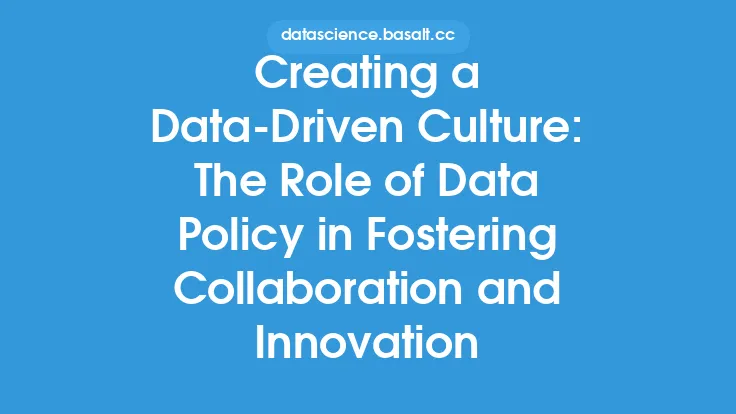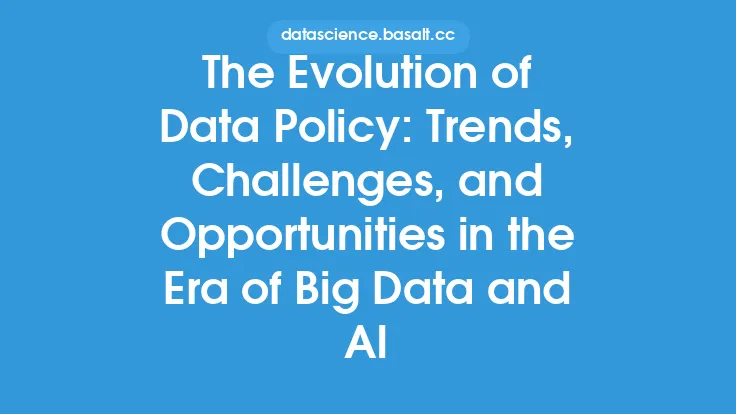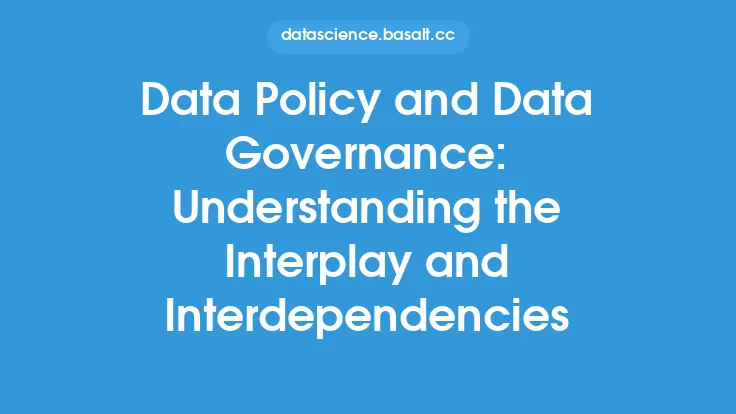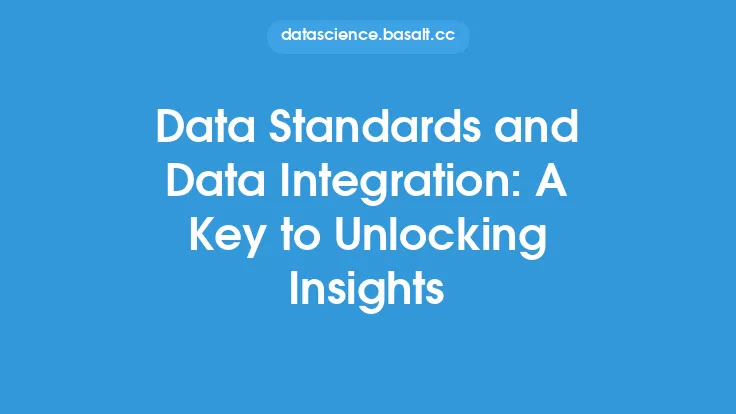Developing a comprehensive data policy is a crucial step in ensuring the effective management and governance of an organization's data assets. A well-crafted data policy provides a clear framework for data collection, storage, processing, and dissemination, and helps to ensure that data is handled in a way that is consistent with organizational goals and objectives. In this article, we will explore the key considerations and guidelines for developing a comprehensive data policy.
Introduction to Data Policy Development
The development of a comprehensive data policy requires a thorough understanding of the organization's data landscape, including the types of data that are collected, stored, and processed, as well as the various stakeholders who interact with that data. It also requires a clear understanding of the organization's goals and objectives, as well as the regulatory and compliance requirements that govern data management. A comprehensive data policy should be designed to balance the needs of various stakeholders, including data owners, data users, and data custodians, while also ensuring that data is handled in a way that is consistent with organizational policies and procedures.
Key Considerations for Data Policy Development
There are several key considerations that should be taken into account when developing a comprehensive data policy. These include:
- Data classification: A comprehensive data policy should include a data classification scheme that categorizes data based on its sensitivity, criticality, and business value. This scheme should be used to determine the level of access, storage, and protection that is required for each type of data.
- Data ownership: A comprehensive data policy should clearly define data ownership and the roles and responsibilities of data owners, data users, and data custodians.
- Data access and authorization: A comprehensive data policy should include procedures for granting and revoking access to data, as well as guidelines for ensuring that access is authorized and authenticated.
- Data storage and retention: A comprehensive data policy should include guidelines for data storage and retention, including procedures for backing up and archiving data, as well as guidelines for destroying or disposing of data that is no longer needed.
- Data security: A comprehensive data policy should include guidelines for ensuring the security and integrity of data, including procedures for encrypting data, protecting against unauthorized access, and detecting and responding to security incidents.
Guidelines for Data Policy Development
In addition to the key considerations outlined above, there are several guidelines that should be followed when developing a comprehensive data policy. These include:
- Involve stakeholders: A comprehensive data policy should be developed in consultation with stakeholders from across the organization, including data owners, data users, and data custodians.
- Conduct a data inventory: A comprehensive data policy should be based on a thorough understanding of the organization's data assets, including the types of data that are collected, stored, and processed.
- Establish clear goals and objectives: A comprehensive data policy should be designed to support the organization's overall goals and objectives, as well as its regulatory and compliance requirements.
- Use plain language: A comprehensive data policy should be written in plain language that is easy to understand, avoiding technical jargon and complex terminology wherever possible.
- Review and revise regularly: A comprehensive data policy should be reviewed and revised regularly to ensure that it remains relevant and effective in supporting the organization's data management needs.
Technical Considerations for Data Policy Development
In addition to the guidelines outlined above, there are several technical considerations that should be taken into account when developing a comprehensive data policy. These include:
- Data architecture: A comprehensive data policy should be based on a clear understanding of the organization's data architecture, including the systems, applications, and infrastructure that are used to collect, store, and process data.
- Data standards: A comprehensive data policy should include guidelines for ensuring that data is collected, stored, and processed in accordance with established data standards, including standards for data format, data quality, and data integrity.
- Data governance: A comprehensive data policy should include guidelines for ensuring that data is governed in a way that is consistent with organizational policies and procedures, including procedures for data quality, data security, and data compliance.
- Data analytics: A comprehensive data policy should include guidelines for ensuring that data is analyzed and used in a way that is consistent with organizational goals and objectives, including guidelines for data mining, data visualization, and data reporting.
Implementing and Enforcing Data Policy
Once a comprehensive data policy has been developed, it is essential to implement and enforce it effectively. This includes:
- Training and awareness: Providing training and awareness programs to ensure that stakeholders understand the data policy and their roles and responsibilities in implementing it.
- Monitoring and auditing: Regularly monitoring and auditing data management practices to ensure that they are consistent with the data policy.
- Enforcement and discipline: Establishing procedures for enforcing the data policy, including disciplinary actions for non-compliance.
- Continuous improvement: Regularly reviewing and revising the data policy to ensure that it remains relevant and effective in supporting the organization's data management needs.
Conclusion
Developing a comprehensive data policy is a critical step in ensuring the effective management and governance of an organization's data assets. By following the key considerations and guidelines outlined in this article, organizations can develop a data policy that supports their overall goals and objectives, while also ensuring that data is handled in a way that is consistent with regulatory and compliance requirements. Remember, a comprehensive data policy is not a one-time task, but rather an ongoing process that requires continuous review, revision, and improvement to ensure that it remains relevant and effective in supporting the organization's data management needs.





